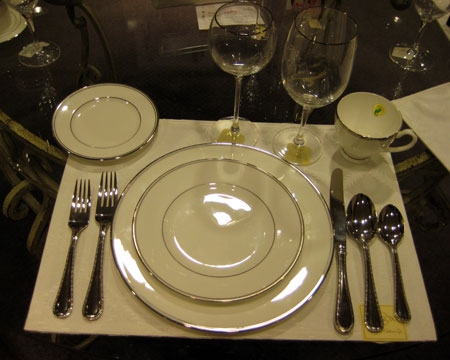5 Tips For Setting The Table
There are lots of ways to set a dinner table and the setup really depends on how fancy-schmancy you want to be. Unless you're regularly entertaining the president or the Duke and Duchess of Cambridge, you probably don't use a full place setting for family meals during the week. So instead of letting your grandmother's silver — or your own fine wedding china — collect dust, why not bring it out and use it occasionally on the weekends? With our easy-to-remember tips below, there is no need to worry, or wish you had a cheat-sheet template for a tablecloth, though these perfect-setting placemats from Cake Vintage are one of our favorites of the year.
1. Getting the flatware right is half the battle
If your parents taught you that the fork and knife sit together to the right of the plate, well... they're wrong.
In general, forks go to the left of your dinner plate and knives and spoons go to the right. The knife blades should always face toward the plate. Remember this by imagining that the knives are protecting the spoons from the evil forks to the left. Wondering what fork is what? Click here to learn more.
2. "B & D" help you remember where things go
If you have a hard time differentiating between left and right — or are always forgetting where you left your glasses (on your head?), this is for you. And no, "b" does not stand for bacon, beer, or booze here — we're talking bread and drinks. (Photo courtesy of Flickr/micah d)
Make remembering where to put the bread-and-butter plate and wine and water glasses easy with this simple hand gesture. Bring your pointer finger and thumb together on each hand and you'll see that your left hand makes a lowercase "b" and your right hand makes a lowercase "d" shape. So put the bread plate up and to the left of the dinner plate (above the forks) and the drinks up and to the right of the dinner plate (above the knives and spoons). And when you're dining with a bread plate, the butter knife follows, sitting horizontally across the center of the plate with the tip of the blade pointing to the left.
3. What do I do with all these glasses?
Line them up, execution-style, across the top of the place setting (or simply forget the water glass)? Wrong again.
Water glasses should be placed directly above the dinner knife. The white-wine glass sits directly to the right of the water glass. If you are serving red wine too, the red-wine glass sits above (closer to the center of the table) and in between the water and white-wine glasses, forming a triangle. If you are only using water and one type of wine glass, keep the water glass above the dinner knife and place the other wine glass to the right and slightly above the water glass.
After all of this pomp and circumstance, tackling napkins is easy. Traditionally, cloth napkins are used for formal meals and may be placed on the center of the dinner plate, underneath the forks, or directly to the left of the forks — the choice is yours. Just refrain from sticking your napkin down your shirtfront, bib-style, leaving it on the floor, or forgetting about it. You can fold them into rectangles or experiment with some fancy folds to give them some personality. (Photo courtesy of Flickr/Phil Hawksworth)
5. The finishing touch
The table is all set, the guests have arrived, and it is nearly time to eat. But where is the water pitcher and the salt and pepper shakers? Eliminate last-minute dinner table crises with our checklist of a few oft-forgotten things that every host should remember:
• Create centerpieces of candles or flowers to go down the center of the table. Read these tips for creating your own centerpieces, or pick up your favorite flower and use these ideas as inspiration. You can also opt to create something completely edible.
• Fill water glasses at the table before your guests arrive. This is a small luxury that is often forgotten. And be sure to have a filled pitcher nearby for refills.
• Eliminate that dreaded "where should I sit" moment of awkwardness by assigning seats. Try dispersing chatty friends around the table to even out the conversation, and seat people who might not know each other, but have something in common, together. This way, your guests won't aimlessly walk around waiting for you to tell them where to sit — and you won't be put on the spot. Here are some conversation starters to try.
• Keep salt and pepper on the table for guests (unless you really like getting up from the table as opposed to enjoying your guests company — and your meal — like a good host).
• Serving coffee? Leave coffee cups and saucers off the table and wait to bring them in with the dessert. It saves you room and is one less piece of glass or china to worry about breaking (and washing, for that matter). Just don't get caught leaving your spoon in your coffee.
• At the end of the night, if you find you've made a flatware flub or got the salt and pepper on the table but forgot to chill an extra bottle of wine, it will be OK, because in the end, a good meal and fine company outweigh everything else.
Click here to see What You Need to Know About Table Settings.
This article was originally published on November 11, 2011.

